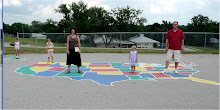




Charles Towne Landing was the original settlement here in 1670, and it's built on high ground (a whopping 10 feet above sea level!); the Europeans settled inland when they realized the natives were hospitable, but the pirates and Spanish were a nuisance to say the least.
The need for trade won out, however, and after only a decade they moved to the current Charleston location -- much of which is below sea level and on the nation's 2nd worst fault line -- both hurricanes and earthquakes can take charge here!
We walked the entire grounds with an audio set, and visited the zoo. It's full of animals that were native to the settlement, but no longer there, like pumas and black bear. Our highlight was definitely the guide on The Adventure, a reproduction boat docked in the marsh.
He was knowledgeable and genuinely into his history, seafaring songs and riddles. When Little Man asked why all the oyster shells were lying on the bank, he responded with, "Well, I ate them!" Then, engaging their noggins he asked, "But why do you think I toss the shells over there?" ((To prevent erosion on the bank and to keep oysters producing!)
He did his best to stay true to the 17th century, but he knew an awful lot about The Hobbit! He got tickled with the kids as we were leaving and the next thing we knew he'd sprinted off the boat and plunked right down on the deck, refusing to let anyone pass until they could answer his riddles. Little did he know, he'd met his match in Peanut!




I am a reenactor new to the Charles Towne Landing site and know that guide from an interpretation class held in Charleston in January 2010. The guide in question lives and breathes the 17th century and is incredibly knowledgable;he is a great asset to the Chareston interpretation community. Thank you so much for appreciating the site and the efforts we put forth to interpret it!
ReplyDelete